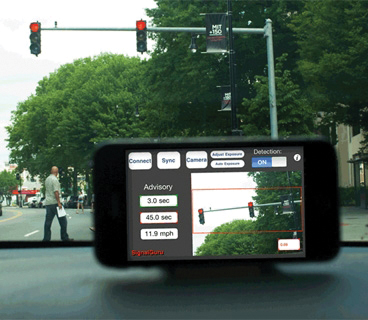|
|
INCREASING FUEL EFFICIENCY WITH A SMARTPHONEWritten by Larry Hardesty
Where previous experimental traffic-light advisory systems used GPS data or data from traffic sensors, Graphic: Christine Daniloff
Cars are responsible for 28 percent of the energy consumption and 32 percent of the carbon dioxide emissions in the United States, says Emmanouil Koukoumidis, a visiting researcher at MIT who led the project. "If you can save even a small percentage of that, then you can have a large effect on the energy that the U.S. consumes," Koukoumidis says. The system is intended to capitalize on a growing trend in which drivers install brackets on their dashboards so that they can use their smartphone as a GPS navigator while driving. But unlike previous in-car cellphone applications, the new system, dubbed SignalGuru, relies on images captured by the phones' cameras. According to Koukoumidis, the computing infrastructure that underlies the system could be adapted to a wide range of applications: The camera could, for instance, capture information about prices at different gas stations, about the locations and rates of progress of city buses, or about the availability of parking spaces in urban areas, all of which could be useful to commuters.
Koukoumidis is a student of Li-Shiuan Peh, an associate In addition to testing SignalGuru in Cambridge, where traffic lights are on fixed schedules, the researchers also tested it in: • Singapore, where the duration of lights varies continuously according to fluctuations in traffic flow. • In Cambridge, where the system was able to predict when lights would change with an error of only two-thirds of a second. • In suburban Singapore, the error increased to slightly more than a second, and at one particular light in densely populated central Singapore, it went up to more than two seconds.
The researchers did model the effect of instructing drivers to accelerate in order to catch lights before they changed, Koukoumidis envisions that the system could also be used in conjunction with existing routing software. Rather than recommending, for instance, that a car slow to a crawl to avoid a red light, it might suggest ducking down a side street.
© 2013 TLC Magazine Online, Inc. |

